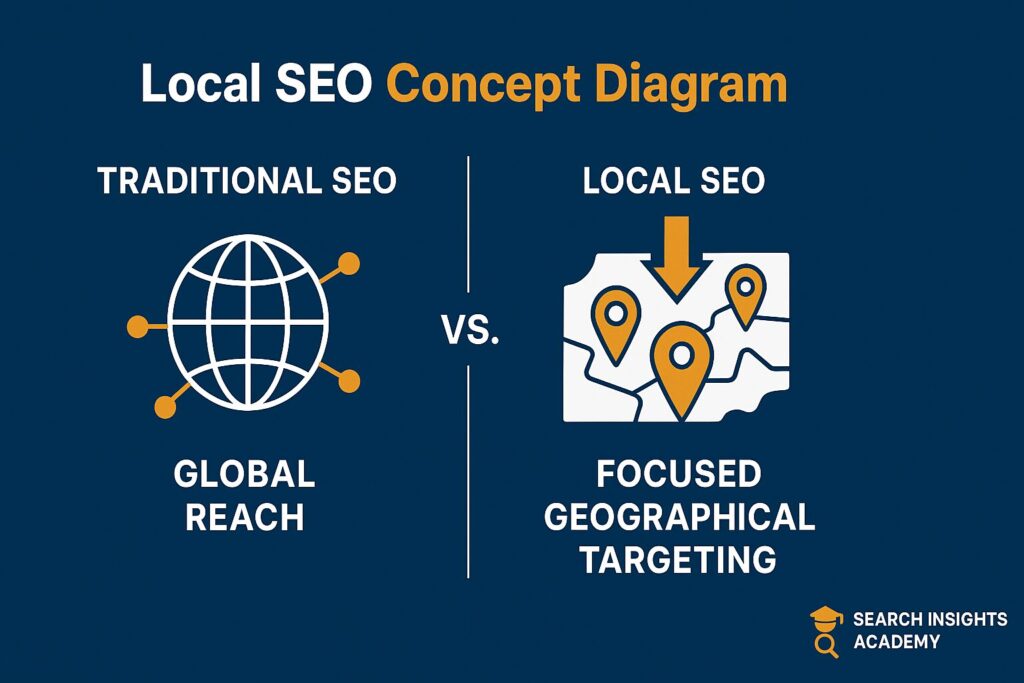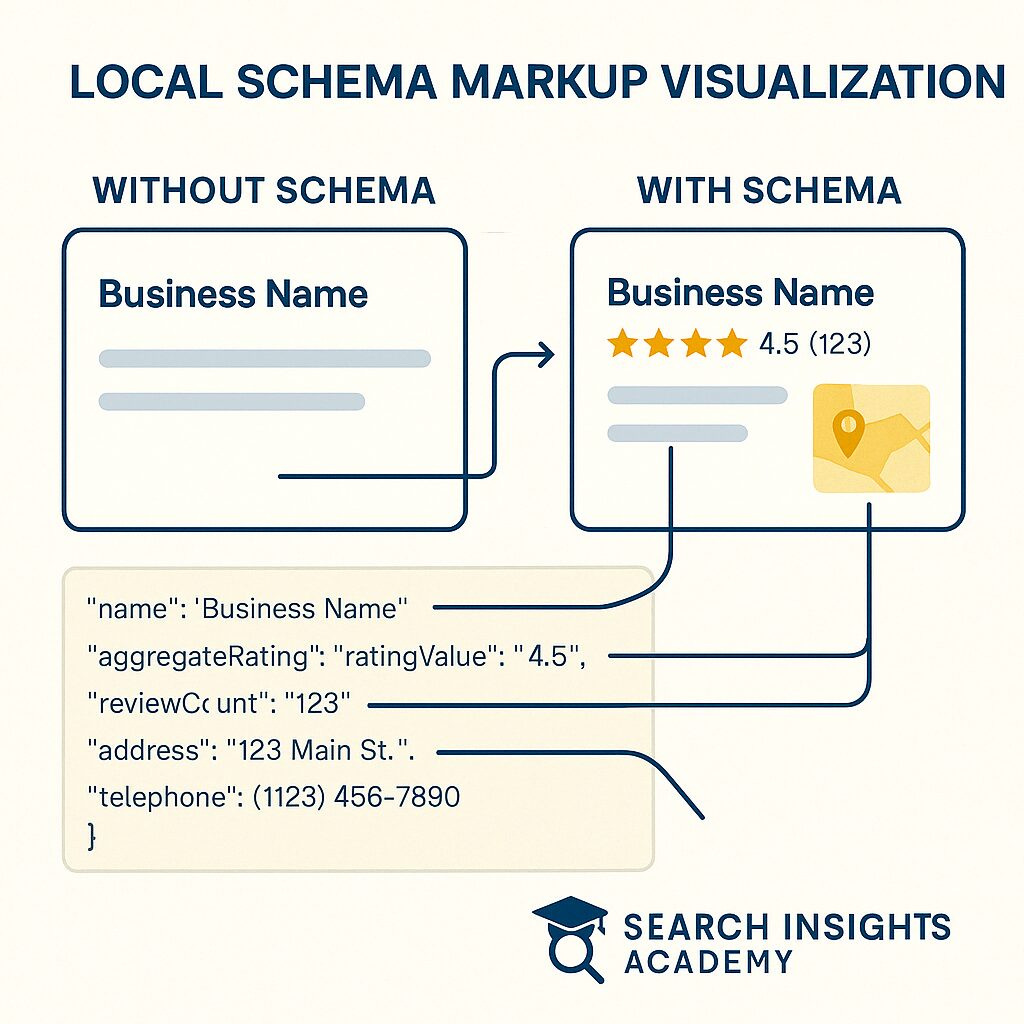Picture this: you’re exploring an unfamiliar neighborhood when hunger strikes. You pull out your phone, type “coffee near me,” and within seconds, you’re walking toward a highly-rated café just two blocks away. This everyday scenario demonstrates the power of local search optimization – connecting businesses with customers precisely when they’re ready to make a purchase decision.
With mobile searches continuously rising worldwide, mastering “near me” SEO has become essential for businesses of all sizes. Local SEO helps your company appear in front of nearby audiences at the exact moment they’re searching for your products or services. When implemented correctly, this targeted approach can dramatically increase your visibility, foot traffic, and revenue.
In this comprehensive guide, we’ll explore the fundamentals of local SEO, proven strategies to optimize for “near me” searches, and practical steps to help your business climb to the top of local search results.
What Is Local SEO?

Local SEO is a specialized branch of search engine optimization focused on improving visibility for location-based searches. Unlike traditional SEO that might target audiences anywhere, local SEO narrows your focus to potential customers in specific geographic areas.
What Is Local SEO?
Local SEO encompasses all techniques used to improve your business’s visibility in location-specific searches. This approach is essential for brick-and-mortar businesses like restaurants and retail stores, but equally valuable for service-based businesses targeting specific regions. According to BrightLocal’s Local Consumer Review Survey, 93% of consumers used the internet to find a local business in 2020, with 34% searching every day.
Why ‘Near Me’ Searches Are Crucial for Businesses
“Near me” searches represent high-intent queries where users share their location with search engines to find relevant nearby options. Google reports that mobile searches for “near me” have grown over 250% in recent years, demonstrating how consumers increasingly rely on their devices for immediate, location-based solutions. Optimizing for these searches means capturing customers at the moment they’re ready to act.
How Local Search Differs Around the World
While local SEO principles remain consistent globally, implementation varies by region. In Australia, mobile usage drives significant local search traffic, while Europeans often rely on region-specific directories. North American users frequently use review platforms like Yelp alongside Google. Understanding these nuances helps you tailor your approach to match how your specific audience searches.
Understanding ‘Near Me’ Keywords

“Near me” searches represent a goldmine of potential business – users searching this way typically have immediate purchase intent and are looking for convenient options they can visit right away.
What Triggers a ‘Near Me’ Search?
Several factors prompt users to perform “near me” searches:
- Immediate needs (coffee, food, gas)
- Service emergencies (locksmith, plumber, towing)
- Location-based research while traveling
- Convenience-driven shopping decisions
According to Google’s data, “near me” searches peak during weekends and evening hours when people are out and about, with over 76% occurring on mobile devices.
The Role of User Intent and Location Data
Search engines rely on several signals to deliver location-based results:
- GPS data from mobile devices
- IP address location
- Previous search history and saved locations
- Explicit location mentions in queries
Understanding this helps you align your content with user intent. Search Engine Journal notes that search engines are increasingly sophisticated at interpreting searches that imply local intent, even without explicit “near me” language.
The Evolution of ‘Near Me’ Keywords
“Near me” keywords have evolved beyond simple proximity searches. Modern users search for specifics like “best pizza near me” or “open now hair salon near me,” combining location with quality indicators and availability. Moz’s local search ranking factors show that businesses optimizing for these combination queries often outperform competitors focusing solely on location.
Preparing Your Website for Local SEO Success
Before diving into specific “near me” optimization tactics, your website needs a solid technical foundation to support your local SEO efforts.
Technical Setup for Website SEO Optimisation

Start with these technical fundamentals:
- Secure your site with HTTPS (Google considers this a ranking factor)
- Create a logical URL structure that includes location terms where appropriate
- Implement a comprehensive XML sitemap to help search engines discover all your pages
- Register your site with Google Search Console and Bing Webmaster Tools for insights and issue alerts
Google’s own SEO starter guide emphasizes these technical elements as the foundation for any successful SEO strategy.
Site SEO Optimization Basics (Mobile-Friendliness, Page Speed)
Mobile optimization is non-negotiable for local SEO success:
- Implement responsive design that works seamlessly across all devices
- Optimize page speed (aim for under 3 seconds loading time)
- Remove intrusive interstitials that hinder mobile user experience
- Ensure tap targets are appropriately sized for finger navigation
According to Google’s PageSpeed Insights research, 53% of mobile users abandon sites that take longer than three seconds to load, directly impacting your conversion potential.
Structured Local Content Strategy
Develop a content plan that naturally incorporates:
- Location-specific service pages for each area you serve
- Local landmarks, neighborhoods, and cultural references
- Solutions to location-specific problems your customers face
- Content that addresses seasonal or regional concerns
Content Marketing Institute’s research shows businesses with locally-relevant content experience 70% higher engagement from regional audiences.
Google Business Profile: Your Key to Top Rankings

A fully optimized Google Business Profile (formerly Google My Business) is the cornerstone of effective local SEO and often the deciding factor in whether you appear in the valuable “Local Pack” results.
Setting Up and Verifying Your Google Business Profile
Follow these steps to establish your presence:
- Create or claim your Google Business Profile
- Choose the most accurate business category
- Enter complete business information (name exactly as it appears on your signage)
- Add your service area and locations
- Verify your listing via postcard, phone, or email (methods vary by business type)
- Complete your profile with photos, services, attributes, and business description
According to BrightLocal, complete Google Business Profiles receive 7x more clicks than incomplete listings.
Essential Details for Better Visibility (NAP Consistency)
NAP (Name, Address, Phone Number) consistency is crucial across all online platforms:
- Ensure your business name, address, and phone number appear exactly the same everywhere online
- Use your actual business name, not keyword-stuffed variations
- Include your complete address with suite numbers and zip/postal codes
- Use a local phone number rather than toll-free numbers for better local relevance
Moz’s local search ranking factors study ranks NAP consistency as one of the top three factors influencing local search performance.
Optimizing Your Business Profile for Maximum Visibility
To maximize your profile’s performance:
- Add high-quality photos that showcase your business (interior, exterior, products, team)
- Create Google Posts weekly to share updates, offers, and events
- Answer questions in the Q&A section proactively
- Set up messaging to allow direct customer communication
- Add products, services, and menu items with descriptions and pricing
- Configure appointment booking if applicable to your business
Google’s own research indicates businesses with photos receive 42% more requests for directions and 35% more website clicks than those without.
On-Page Optimisation Strategies
On-page optimization remains fundamental to helping search engines understand your local relevance and authority.
Incorporating Location Keywords and ‘Near Me’ Phrases
Strategically place location terms throughout your content:
- Include city/region names in page titles where relevant
- Incorporate neighborhood names in headings and content
- Create naturally flowing content about local topics
- Consider location-based FAQ sections that address “near me” concerns
While you can’t directly optimize for “near me” (since it refers to the searcher’s location), Search Engine Journal explains that optimizing for local relevance signals helps you appear in these results.
Title Tags, Meta Descriptions, and Schema Markup

Optimize your metadata with local intent:
- Include location terms in title tags (e.g., “Artisan Coffee Shop | Downtown Seattle”)
- Write meta descriptions that highlight local value propositions
- Implement local business schema markup to provide structured data about your location, hours, services, and reviews
- Use additional relevant schema types like Product, FAQ, and Event markup for richer results
Schema.org offers detailed guidelines on implementing local business markup correctly.
Creating Location-Specific Landing Pages
For businesses serving multiple locations:
- Create unique, content-rich pages for each location
- Include location-specific testimonials and case studies
- Add Google Maps embeds showing your exact location
- Provide area-specific information (parking, public transport, nearby landmarks)
- Avoid duplicate content across location pages
SEMrush research shows location pages with unique, valuable content perform 25-30% better than generic pages with only address changes.
Leveraging Local Citations and Directories
Beyond Google, your business should maintain a consistent presence across the broader local search ecosystem.
Building a Strong Citation Profile
Citations are mentions of your business name, address, and phone number online:
- Focus first on primary citation sources (Google Business Profile, Apple Maps, Bing Places, Facebook)
- Target industry-specific directories relevant to your business category
- Seek out local directories specific to your city or region
- Maintain consistent NAP information across all platforms
A BrightLocal study found businesses with accurate citations on relevant platforms saw a 58% greater likelihood of ranking in Google’s Local Pack.
Best Local Search Engines and Directories Worldwide

While Google dominates globally, other platforms matter too:
- North America: Yelp, Yellow Pages, Better Business Bureau, Angie’s List
- Europe: European Directories, Yelp, local country-specific platforms
- Australia: True Local, Yellow Pages Australia, Yelp Australia
- Asia: Baidu Maps (China), Naver (Korea), Tabelog (Japan food)
Industry-specific directories also carry significant weight – for restaurants, TripAdvisor and OpenTable; for hotels, Booking.com and Expedia; for healthcare, Healthgrades and ZocDoc.
Updating and Maintaining Consistent Listings
Listing management requires ongoing attention:
- Conduct regular audits of your citation profile (tools like BrightLocal can help)
- Promptly update all listings when business details change
- Remove or correct duplicate listings that can confuse search engines
- Respond to reviews across all platforms
A Moz survey found that 68% of consumers would stop using a local business if they found incorrect information online.
Building Trust with Reviews and Ratings

Reviews have become a critical factor in both search rankings and consumer decision-making.
The Impact of Reviews on Local Search Rankings
Reviews influence your visibility in several ways:
- Quantity of reviews signals popularity to search engines
- Review velocity (how often you receive new reviews) indicates relevance
- Review diversity across multiple platforms builds authority
- Keywords in reviews can help you rank for specific terms
BrightLocal’s research shows businesses with 4+ star ratings are chosen by consumers 92% of the time over lower-rated competitors.
Encouraging Positive Feedback
Implement a systematic approach to gathering reviews:
- Train staff to politely request reviews after positive interactions
- Create a simple review generation process with direct links to your profiles
- Send follow-up emails with review requests after purchases or service completion
- Consider review management software to streamline the process
- Offer multiple platform options (Google, Facebook, industry-specific sites)
According to GatherUp, businesses that actively request reviews see 6-10 times more reviews than those that don’t.
Responding to Reviews Professionally
Your response strategy is as important as the reviews themselves:
- Respond to all reviews, both positive and negative, within 24-48 hours
- Thank positive reviewers and add personal details that reference their experience
- Address negative reviews with empathy and solutions
- Avoid defensive language or excuses when handling criticism
- Take complex issues offline with direct contact information
Harvard Business Review research found businesses that respond to reviews see rating improvements of 0.12 stars on average and increased review volume.
Advanced ‘Near Me’ SEO Tactics
Once you’ve mastered the fundamentals, these advanced strategies can further enhance your local visibility.
Hyperlocal Content Marketing
Create content that resonates with your specific community:
- Develop neighborhood guides relevant to your business area
- Publish locally focused blog posts about community events
- Create resources addressing region-specific challenges
- Feature local customer success stories
- Partner with neighboring businesses for collaborative content
Content Marketing Institute reports that hyperlocal content drives 6x more engagement than generic content.
Local Link Building Strategies
Build authority through locally relevant backlinks:
- Partner with local business associations and chambers of commerce
- Sponsor community events for backlink opportunities
- Create newsworthy stories that local media will want to cover
- Guest post on local blogs and news sites
- Get listed in local college or university resource pages if relevant
Ahrefs research shows local businesses with strong backlink profiles from regional websites rank 23% higher in local search results.
Local Social Media Engagement
Leverage social platforms to strengthen local presence:
- Create and optimize location-specific social profiles
- Use local hashtags relevant to your community
- Engage with local influencers and businesses
- Share content about local events, news, and developments
- Run geo-targeted ad campaigns to reach nearby customers
Hootsuite’s analysis reveals businesses with active local social engagement see 29% higher conversion rates from local searches.
Tracking and Measuring Your Progress

Effective measurement helps you refine your strategy and demonstrate ROI from your local SEO efforts.
Tools for Monitoring Local Keywords and Competitors
Invest in tools that provide local search insights:
- BrightLocal for local rank tracking and citation monitoring
- Semrush or Ahrefs for position tracking with local parameters
- Google Search Console for actual search performance data
- Google Analytics with geographic segmentation
- Whitespark’s Local Rank Tracker for precise local SERP monitoring
Interpreting Local SEO Metrics (Rankings, Traffic, Conversions)
Focus on these key performance indicators:
- Local pack rankings for primary keywords
- Click-through rates from local results
- Website traffic from local areas (geographic report in Analytics)
- Conversion rates from local visitors
- Phone calls, direction requests, and direct messages from Google Business Profile
Moz’s State of Local SEO Industry Report found businesses tracking a combination of these metrics were 76% more likely to report positive ROI from local SEO.
Continuous Improvement Through Testing
Implement an ongoing testing methodology:
- A/B test different Google Business Profile elements (photos, descriptions, categories)
- Try various approaches to review solicitation
- Test different local content formats
- Experiment with different schema markup types
- Adjust bid strategies for local search ads
Search Engine Land recommends quarterly review and adjustment of local SEO strategies based on performance data.
Common Pitfalls and How to Avoid Them
Even experienced marketers can fall into these local SEO traps. Here’s how to avoid them.
Over-Optimising with ‘Near Me’ Keywords
Avoid these counterproductive tactics:
- Stuffing “near me” unnaturally into on-page content (Google determines proximity, not your keywords)
- Creating artificial location names in your business title
- Generating doorway pages with minimal value beyond location keywords
- Using location keywords in ALT tags where they don’t describe the image
Google’s quality guidelines explicitly warn against keyword stuffing and irrelevant keyword usage.
Neglecting Google Business Profile Updates
Common maintenance mistakes include:
- Failing to update seasonal hours or temporary closures
- Ignoring customer questions in the Q&A section
- Allowing old photos to represent your current business
- Not posting updates, offers, or events regularly
- Overlooking changes to your services or product offerings
Sterling Sky’s research shows businesses posting weekly on Google Business Profile see 520% more actions from their listings than inactive businesses.
Ignoring Review Management
Review-related pitfalls to avoid:
- Failing to respond to negative reviews promptly
- Using templated, generic responses to all reviews
- Asking for reviews in bulk rather than as part of the natural customer journey
- Violating platform policies by incentivizing positive reviews
- Becoming defensive or confrontational in public responses
ReviewTrackers found 53% of customers expect businesses to respond to negative reviews within a week, yet 63% say they’ve never received a response to their review.
Conclusion and Next Steps

Key Takeaways on ‘Near Me’ Optimisation
Local SEO success requires a multifaceted approach:
- A technically sound, mobile-friendly website forms your foundation
- Google Business Profile optimization is essential for local pack visibility
- NAP consistency across all platforms builds search engine trust
- Reviews and citations reinforce your local authority
- Location-specific content connects you with nearby searchers
Understanding how “near me” searches work enables you to position your business precisely where and when potential customers are looking.
Actionable Tips to Increase Local Search Visibility
Start implementing these high-impact strategies today:
- Complete your Google Business Profile with comprehensive information, photos, and regular posts
- Audit and correct NAP inconsistencies across the web
- Develop a systematic review generation and response process
- Create locally relevant content addressing community-specific needs
- Build relationships with other local businesses for networking and backlink opportunities
As Neil Patel explains, these fundamentals consistently drive local search success across all business types.
Final Thoughts on Sustaining Local SEO Success
Local SEO isn’t a one-time project but an ongoing business practice:
- Regularly monitor your performance metrics and adjust strategies accordingly
- Stay updated on local algorithm changes through industry publications
- Continue building your online reputation through exceptional service and review management
- Adapt your approach as your business grows or service areas change
- Recognize that local SEO is ultimately about connecting real people with the solutions they need
By committing to these principles, businesses of any size can achieve sustainable visibility in their communities and turn “near me” searches into loyal customers.Add to Conversation


